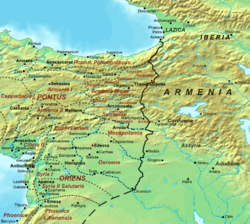Lesser Armenia
This article needs additional citations for verification. (January 2023) |
| History of Armenia |
|---|
 |
| Timeline • Origins • Etymology |
Lesser Armenia (
Geography
Lesser Armenia (or Armenia Minor) was the portion of historic
It received its name to distinguish it from the much larger eastern portion of historic Armenia—Greater Armenia (or Armenia Major).Early history
Lesser Armenia may have formed a part of the territories of the Orontid dynasty, which ruled Armenia first as satraps of the Achaemenid Empire and then as kings.[5] However, there is no clear evidence to support this claim.[5] Lesser Armenia emerged as a separate kingdom after the Treaty of Apamea in 188 BC, although the exact origin, size and history of this kingdom are murky.[6] The capital of this kingdom was probably originally at Kamakh, but likely moved to Nicopolis after the end of the Mithridatic Wars.[6] Lesser Armenia apparently experienced the high point of its territorial expansion during the Orontid period, possibly expanding its borders to the Black Sea.[5] According to Strabo, it originally had its own royal dynasty.[7] It passed under the control of the Kingdom of Pontus in the 1st century BC, during the reign of Mithridates VI Eupator (r. 120 – 63 BC), who built 75 fortresses there.[7] After the Romans defeated Pontus in the Mithridatic Wars, Lesser Armenia became a client kingdom of Rome, who appointed various client kings to rule the kingdom.[7] The last of these was Aristobulus of Chalcis of the Herodian dynasty.[7] In 72 AD, Lesser Armenia was annexed by the Roman Empire and made a part of the larger province of Cappadocia.[8]

Roman and Byzantine Lesser Armenia
All of Armenia became a
Lesser Armenia was reunited with the kingdom of Greater Armenia under the Arshakuni king Tiridates III in AD 287 until the temporary conquest of Shapur II in 337.[citation needed]
Then it was formed into a regular province under
Its population remained Armenian but was being gradually Romanized. Since the 3rd century many Armenian soldiers were in the Roman army: later–in the 4th century–they made up two Roman legions, the Legio I Armeniaca and the Legio II Armeniaca.[citation needed]
In 536, the emperor Justinian I reorganized the provincial administration, and First and Second Armenia were renamed Second and Third respectively, while some of their territory was split off to the other Armenian provinces.[citation needed]
The borders of the Byzantine part of Armenia were expanded in 591 into Persarmenia, but the region was the focus of decades of warfare between the Byzantines and the Persians (the
After this, the part of Lesser Armenia remaining under Byzantine control (in a lesser extent) became part of the theme of
Mongol and Ottoman influence
After the downfall of Bagratid Armenia in 1045 and resulting subsequent losses of Byzantine Empire in the East in 1071 (after the
Between the 11th and 14th centuries, the term Lesser Armenia (sometimes called "Little Armenia") was applied to the Armenian Kingdom of Cilicia, right until the formation of Turkey in 1923.
Episcopal sees
Ancient episcopal sees of the Roman province of Armenia Prima (I) listed in the Annuario Pontificio as titular sees:[11]
- Berissa
- Colonia in Armenia (Köylühisar) (Armenian Catholic Church)
- Nicopolis in Armenia
- Pedachtoë (Bedochton, Pedachton)
- Satala in Armenia
- Sebastea (Sivas)
- Sebastopolis in Armenia(Sulusaray)
Ancient episcopal sees of the Roman province of Armenia Secunda (II) listed in the Annuario Pontificio as titular sees:[11]
- Arabissus
- Arca in Armenia (Arga)
- Ariarathia (Aziziye)
- Comana Armeniae(Sar or Sarkale)
- Cucusus(Göksun)
- Melitene(Malatya)
- Verissa
For ancient episcopal sees of the Roman province of Armenia Tertia (III), see Roman Armenia#Episcopal sees.
Later history
Lesser Armenia is traditionally considered as part of
The Christian Armenian population of Lesser Armenia continued its existence in the area until the Armenian genocide of 1915–23. Some Armenians still live in the area, albeit converted to Islam under Ottoman influence, mainly in the 17th century.[citation needed]
See also
- Hemshinli
Notes
- ^ Adontz 1970, p. 311.
- ^ a b Harutiunian 1986, p. 373a.
- ^ a b Petrosyan 2014, p. 108.
- ^ Petrosyan 2007, p. 43.
- ^ a b c Hewsen 2001, p. 32.
- ^ a b Hewsen 2001, pp. 32, 37.
- ^ a b c d Hewsen 2001, p. 37.
- ^ Hewsen 2001, pp. 37, 48.
- ^ Peter Edmund Laurent (1830). An Introduction to the Study of Ancient Geography. With copious indexes. Oxford: Henry Slatter. pp. 233–234.
- ^ Peter Edmund Laurent (1830). An Introduction to the Study of Ancient Geography. With copious indexes. Oxford: Henry Slatter. p. 234.
- ^ ISBN 978-88-209-9070-1), "Sedi titolari", pp. 819-1013
- ISBN 1598849484
References
- Adontz, Nicolas (1970). The Reform of Justinian Armenia. Translated with partial revisions, a bibliographical note, and appendices by Nina G. Garsoïan. Lisbon: Calouste Gulbenkian Foundation.
- Chahin, Mack (2001). The Kingdom of Armenia: A History. London: Routledge. ISBN 0-7007-1452-9.
- Harutiunian, B. (1986). "Pʻokʻr Haykʻ" Փոքր Հայք. Haykakan sovetakan hanragitaran Հայկական սովետական հանրագիտարան [Armenian Soviet Encyclopedia] (in Armenian). Vol. 12. Yerevan. pp. 373–374.
{{cite book}}: CS1 maint: location missing publisher (link) - ISBN 0-226-33228-4.
- "Kingdom of Greater Armenia". Oxford Reference. Retrieved 20 November 2013.
- Petrosyan, Armen (2014). Armenovedcheskie issledovanii͡a Арменоведческие исследования [Armenological studies] (in Russian). Yerevan: Antares. ISBN 978-9939-51-697-4.
- Petrosyan, Armen (2007). "The Problem of Identification of the Proto-Armenians: A Critical Review". Journal of the Society for Armenian Studies. 16: 43.
- Vaux, Bert (2001). Hemshinli: The Forgotten Black Sea Armenians (PDF). Harvard University. Archived from the original (PDF) on 15 March 2007.



